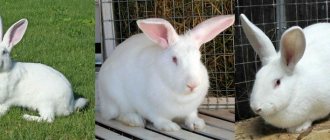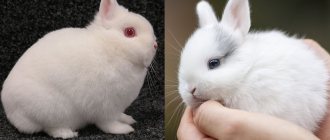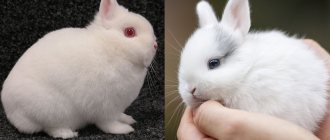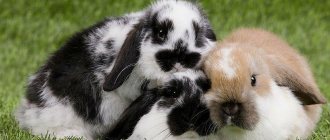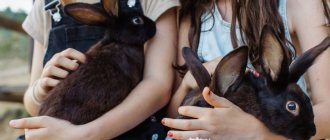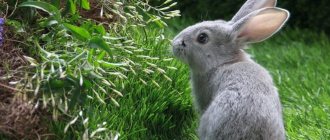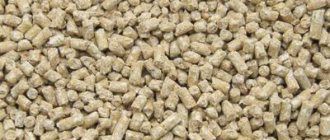Breeders of cute and fluffy animals should have reliable information about how much a rabbit weighs and when the animal gains the most weight. Such information will help determine the effectiveness of the selected food and the time when the rabbit will produce the largest amount of meat when slaughtered. It is worth noting that each breed of animal has an individual growth rate.
Weight by breed
When choosing a breed, beginning rabbit breeders rely on maximum weight and conditions for weight gain. At the same time, they are studying the influence of various factors on the growth rate of rabbits.
| Breed | Weight, kg |
| Butterfly, Silver | 4-6 |
| Belgian Flanders | 6-12 |
| White giant | 6-8 |
| Blue Royal Giant, Californian, Soviet Chinchilla | 4-5 |
| German giant | 7-9 |
| New Zealand | 4,5-6 |
| Gray giant | 4-7 |
| Soviet Marder | 3-4,5 |
| French ram | 6-7, 5 |
| Black-brown | 5-7 |
A few words about the factors influencing weight gain
Various factors influence weight gain in rabbits, including the following:
All the conditions listed above will determine the speed at which the rodents will gain weight and what the final weight gain will be for the month.
For almost every breed group, experts have developed tables containing data on the expected weight gain for each month of the rabbit’s existence. But here you need to remember that the values are averaged; in real life they vary greatly.
To regulate the weight of rodents, livestock breeders have long used various techniques, for example:
Source
Weight by month
Each animal has its own characteristics and develops individually. By monitoring the growth of rabbits of different breeds, scientists derived average growth rates by month. Animals usually gain maximum weight for slaughter by the 8th month of life, sometimes by a year.
| Breed | Weight, g | |||||||||
| Age, months | 0 | 1 | 2 | 3 | 4 | 5 | 6 | 7 | 8 | |
| Butterfly | 50 | 600 | 1600 | 2400 | 3200 | 3600 | 3900 | 4100 | 4300 | |
| Belgian Flanders | 100 | 800 | 2600 | 3600 | 4700 | 5500 | 6300 | 7000 | ||
| White giant | 70 | 700 | 2300 | 3400 | 3800 | 4200 | 4600 | 5000 | ||
| Blue Royal Giant | 600 | 2100 | 2900 | 3200 | 3600 | 4000 | 4200 | |||
| Californian | 50 | 500 | 1500 | 2700 | 3100 | 3500 | 3800 | 4100 | 4300 | |
| German giant | 900 | 1200 | 3200 | 4800 | 6400 | 7100 | 7800 | 8500 | 9000 | |
| New Zealand | 60 | 600 | 1600 | 2500 | 3200 | 3500 | 3800 | 4100 | 4300 | |
| Silver | 500 | 1500 | 2200 | 3100 | 3700 | 4200 | 4700 | 5000 | ||
| Gray giant | 600 | 3000 | 3600 | 4100 | 4600 | 4800 | ||||
| Soviet Marder | 500 | 1400 | 2100 | 2900 | 3200 | 3600 | 4000 | 4200 | ||
| Soviet chinchilla | 600 | 1500 | 2800 | 3100 | 3500 | 4000 | 4300 | 4800 | ||
| French ram | 80 | 1000 | 2400 | 2600 | 3800 | 4300 | 4400 | 5300 | 5500 | |
| Black-brown | 700 | 1600 | 2500 | 3200 | 3600 | 4000 | 4500 | 4800 | ||
Choice and cost
The cost of giant rabbits differs depending on the variety. But all these breeds are quite rare and not the cheapest.
However, when purchasing such a pet for your home, you should not look for the lowest price. It is better to go to a good nursery, look at the parents of the future pet or pair, and purchase individuals with a pedigree and recommendations for keeping and breeding.
If you are choosing young animals for fattening, then it is better to go to a large rabbit breeding farm and select giant rabbits there.
Sick individuals can be seen immediately - they have swollen or watery eyes, a lethargic appearance, inappropriate behavior, dirty fur, and drooling.
A healthy rabbit is cheerful and cheerful, eats with appetite, its fur is thick and has no bald spots, and its eyes are clear and shiny.
Source
Growth characteristics of rabbits
Rabbits are born blind, with 16 baby teeth. After a week, their body is covered with the first fluff; over the course of a month it increases and by the 25th day it becomes full-fledged fur.
On the tenth day of life, they open their eyes, and on the 20th they are able to leave the home and eat food. Milk teeth fall out on the 18th day of life, after 10 days permanent teeth appear.
The period of birth influences the development of newborns. Those born in winter or early spring grow faster, unlike rabbits born in summer or autumn. Babies are born very tiny, weighing 40-100 grams. After a week, their weight doubles, and within a month - 10 times.
This is facilitated by the composition of mother's milk, enriched with nutrients: fats 10-20%, proteins 13-15%, calcium 0.60-0.70%, phosphorus 0.40-0.50%, milk sugar 2%.
Lactating females produce milk abundantly in the summer. The highest rates are for Californian and Soviet chinchillas, the lowest for New Zealand ones.
Until 3-4 months, the growth rate of rabbits is high, then gradually decreases. At this age they become sexually active. They have a very weak spine and limbs that they can easily break. The skeleton is fully formed by the first year of life.
Mr. Tail recommends: feeding
For giant rabbits, a properly balanced diet is very important, since almost all of their varieties are prone to overeating and obesity.
It is very important to keep the feeders and drinkers clean. It is better to make them remote, mounted, or use heavy containers.
If these large animals turn them over, the rabbitry will always be damp and dirty.
In addition, the gigantic dimensions often lead to a lack of minerals; it is important to add vitamin supplements to the feed, keep chalk and special grinding stones in the cages.
A small photo gallery of giant rabbits:
What affects weight gain
In addition to genetic data, a properly formed diet is important. It includes different types of feed, vitamins and minerals. Rabbits have a very unique digestive system (food should always be in the gastrointestinal tract), so they are fed in small portions several times a day: 4 times for a nursing rabbit and newborns, for other animals 2-3 times are enough. But there should be hay in the cage all the time. Access to clean drinking water is provided freely.
For the normal functioning of the gastrointestinal tract, it is necessary to adhere to the chosen diet and avoid sudden changes in food. Of the vitamins, special attention should be paid to A, D, C, E, B.
There are special additives - growth stimulants. They not only accelerate weight gain, but also strengthen the immune system and build resistance to diseases. The dose of such a drug is calculated based on the nutritional characteristics and age of the animal.
The growth of rabbits depends on their physical condition. To maintain the health of individuals, they organize comfortable living conditions, adequate care, and maintain high-quality nutrition.
How much do rabbits gain depending on age?
Rabbit farming is far from the last place in the livestock industry. Long-eared rodents are kept not only by owners of large complexes, but also by owners of summer cottages. Most modern breeds are unpretentious to living conditions, which makes rabbits very popular for breeding. The value of animals is represented not only by delicious meat products, but also by down and skins.
Each breeder is recommended to know how much weight a rabbit of a particular breed can gain by the time of slaughter, and for this it is necessary to become familiar with the characteristics of various animals, which will be discussed further.
Record holders among long-eared animals
Ralph Rabbit's story is like a roller coaster. Paulina Grand's ward is considered the largest. But doctors are seriously concerned about the pet’s well-being. Today, the weight of the big-eared celebrity is 22 kg, although the owner assures that she provides the rabbit with physical exercise. However, the giant is outwardly active and does not show any dissatisfaction with its maintenance or care. The body length of the playful domestic hare is 130 cm.
Darius is another former Belgian breed record holder. In 2010, he even managed to dislodge Ralph, however, after that he lost ground with a weight of 19 kg. His owner, Annette Edwards, had previously registered large rabbits in the Book of Records; they were the parents of Darius. Apparently, the hereditary factor played a huge role in this particular case. The length of the body in 2010 was inferior to the current leader. True, according to some reports, the pet will soon snatch the palm from Ralph again. The owner claims that the rabbit gained weight 22.2 kg and grew to 130 cm.
Jeff is the son of Darius, so it is not surprising that the whole world expects big victories from him. Annette, as a specialist in breeding ornamental breeds, is confident that Jeff will become a record holder. Now the rabbit is 3 years old, but its body length is already 95 cm. Miss Edwards is happy to tell the secret of such success in an interview. First of all, this is a balanced diet, as well as physical exercise. For example, Darius’s weight, as Annette admits, is largely determined by muscles. He is very active, runs constantly, and his caring owner spends the lion's share of her financial resources on quality maintenance. The price of good food for large breeds is high, which forces the farmer to turn to relatives for help.
History of origin
This subspecies of rabbits was bred in 1910 in one of the states of America. Selection experiments were carried out on albino individuals of the New Zealand subspecies of the red breed. Subsequently, breeding of animals was carried out between the best selected individuals. They were selected for early maturity at an early age. The following characteristics were important:
- Volume of meat products;
- High slaughter weight;
- Quality of meat and fur;
- Snow-white shade of wool.
Selected individuals were crossed with the Flanders breed. Selection experiments were required in order to eliminate overdevelopment of body weight and constitution.
By 1958, the subspecies had become widespread. The breed's first popularity came in Europe. At the end of the 90s, the subspecies took first place among the leading breeds. The subspecies was distributed in Great Britain, Germany and Italy.
In the USSR, rabbits of the white subspecies appeared in the early 70s. Individuals easily adapted to the natural conditions of the country. The subspecies has spread throughout all regions. Currently, animals are kept on farms, homesteads and private farms.
Nutritional supplements for artificial weight gain
To improve appetite, breeders add vitamins to pet food. Beneficial substances of groups A and E are used together with fats, vitamin D is added to thick and porridge-like food. The drink is diluted with vitamin C.
After consultation with a veterinarian, animals are prescribed vitamin-mineral, as well as protein-vitamin-mineral supplements (PVMD).
They strengthen the animals’ bodies with useful microelements: manganese, calcium, phosphorus. Protein-containing options provide protein to the animal's muscles.
Vitamin and protein supplements have no contraindications. The correct dosage is calculated taking into account the body weight and age of the pet. The use of additives above the norm worsens the taste characteristics of rabbit meat.
A proper diet is the key to health!
I will repeat a common truth, which, however, most rabbit breeders lose sight of: rabbit food must be perfectly balanced. As experienced rabbit breeders say: If you feed only hay, the rabbit will only grow ears. Translating into a more scientific language, I will say that the speed of weight gain and the condition of the gastrointestinal tract of animals depend on the quality and calorie content of food.
Feeding only hay is an extremely low-calorie diet that will support life and healthy intestinal motility. To gain weight, animals need to be fed grain bait, whole grain or crushed grain. In addition, they are given mineral supplements and soft food. Instead of creating a menu manually, it is easier to purchase ready-made feed - a balanced mixture of grains, bone meal and minerals.
A varied diet is the key to the health and rapid growth of a rabbit.
Minerals are especially needed by breeding animals and those breeds that are raised for fur. Grain mixtures containing legumes, corn, sunflower or rapeseed are available for sale. These supplements are high in calories and promote weight gain.
There are foods that are contraindicated for animals:
- fresh grass on which pathogenic bacteria are present, because in 95% of cases, epidemics that can destroy livestock in the territory of an entire village are transmitted precisely through fresh leaves;
- some types of plants containing toxins: foxglove, lily of the valley, henbane, colchicum, lumbago, buttercup and others;
- branches of stone fruit trees and the essential oils they contain are toxic to animals;
- bread crumbs can clog the intestines, which leads to the painful death of animals within 24 hours.
